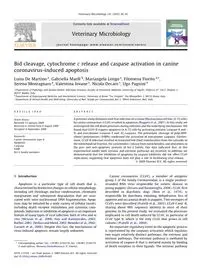
2010 Bid cleavage, cytochrome c release and caspase activation in canine coronavirus-induced apoptosis PDF
Preview 2010 Bid cleavage, cytochrome c release and caspase activation in canine coronavirus-induced apoptosis
Bid cleavage, cytochrome c release and caspase activation in canine coronavirus-induced apoptosis Luisa De Martino a, Gabriella Marfe´ b, Mariangela Longo a, Filomena Fiorito a,*, Serena Montagnaro a, Valentina Iovane a, Nicola Decaro c, Ugo Pagnini a a Department of Pathology and Animal Health, Infectious Diseases, Faculty of Veterinary Medicine, University of Naples ‘‘Federico II’’, Via F. Delpino 1, 80137 Naples, Italy b Department of Experimental Medicine and Biochemical Sciences, University of Rome ‘‘Tor Vergata’’, Via Montpellier 1, 00133 Rome, Italy c Department of Animal Health and Well-being, University of Bari, Strada per Casamassima Km 3, 70010 Valenzano, Bari, Italy 1. Introduction Apoptosis is a particular type of cell death that is characterizedby distinctive changes in cellular morphology, including cell shrinkage, nuclear condensation, chromatin margination and subsequent degradation that are asso- ciated with inter-nucleosomal DNA fragmentation. Apop- tosis may be initiated by a wide variety of cellular insults, including death receptor stimulation and cytotoxic com- pounds. Induction or inhibition of apoptosis is an important feature of many types of viral infection, both in vitro and in vivo (McLean et al., 2008; Hay and Kannourakis, 2002; Barber, 2001; Derfuss and Meinl, 2002; Benedict et al., 2002; Garnett et al., 2006). Despite this fact, the mechanisms of virus-induced apoptosis remain largely unknown. Canine coronavirus (CCoV), a member of antigenic group 1 of the family Coronaviridae, is a single positive- stranded RNA virus responsible for enteric disease in young puppies (Decaro and Buonavoglia, 2008). CCoV, first described in diarrhoeic dogs (Binn et al., 1974), is responsible for diarrhoea, vomiting, dehydration, loss of appetite and occasional death in puppies. Two serotypes of CCoVs were described (Pratelli et al., 2003), CCoV-I and -II, sharing about 90% sequence identity in most of their genome. In the present study, we evaluated the processes implicated in cell death induced by CCoV, in particular of CCoV type II, which is the only CCoV that grows in cell cultures (Pratelli et al., 2004). An important regulatory event in the apoptotic process is represented by the caspases activation which regulates two major relatively distinct pathways, the extrinsic and intrinsic pathways. The extrinsic pathway is mediated by activation of caspase-8 that is initiated mainly by binding of death receptors to their ligands. The intrinsic pathway Veterinary Microbiology 141 (2010) 36–45 A R T I C L E I N F O Article history: Received 13 January 2009 Received in revised form 6 August 2009 Accepted 4 September 2009 Keywords: Canine coronavirus type II Apoptosis Caspases PARP Bcl-2 family members A B S T R A C T A previous study demonstrated that infection of a canine fibrosarcoma cell line (A-72 cells) by canine coronavirus (CCoV) resulted in apoptosis (Ruggieri et al., 2007). In this study, we investigated the cell death processes during infection and the underlying mechanisms. We found that CCoV-II triggers apoptosis in A-72 cells by activating initiator (caspase-8 and - 9) and executioner (caspase-3 and -6) caspases. The proteolytic cleavage of poly(ADP- ribose) polymerases (PARPs) confirmed the activation of executioner caspases. Further- more, CCoV-II infection resulted in truncated bid (tbid) translocation from the cytosolic to the mitochondrial fraction, the cytochrome c release from mitochondria, and alterations in the pro- and anti-apoptotic proteins of bcl-2 family. Our data indicated that, in this experimental model, both intrinsic and extrinsic pathways are involved. In addition, we demonstrated that the inhibition of apoptosis by caspase inhibitors did not affect CCoV replication, suggesting that apoptosis does not play a role in facilitating viral release. � 2009 Elsevier B.V. All rights reserved. * Corresponding author. Tel.: +39 081 2536178; fax: +39 081 2536179. E-mail address:
